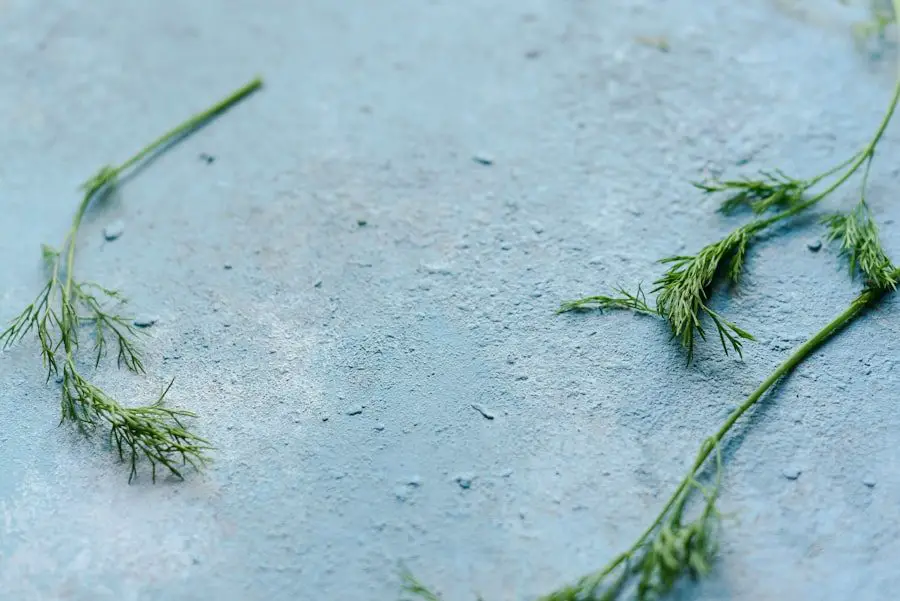
Dill is an herb that has been used for centuries in various cultures around the world. It is believed to have originated in the Mediterranean region and has since spread to other parts of Europe, Asia, and North America. The herb is known for its feathery leaves and delicate yellow flowers, which give it a unique appearance.
Dill has a long history of culinary and medicinal uses. In cooking, it is often used as a flavoring agent in dishes such as soups, stews, salads, and pickles. It has a fresh and slightly tangy flavor that pairs well with a variety of ingredients. In addition to its culinary uses, dill also has several health benefits. It is rich in vitamins and minerals, and has been used in traditional medicine to treat digestive issues, insomnia, and respiratory problems.
Key Takeaways
- Dill is a versatile herb with origins in the Mediterranean and Western Asia.
- Dill has numerous health benefits, including aiding digestion and reducing inflammation.
- Dill can be used in a variety of dishes, from salads and soups to seafood and cocktails.
- Dill is a popular ingredient in pickling, adding a tangy and flavorful twist to summer produce.
- Home gardeners can easily grow and store dill for year-round use in their cooking.
The Health Benefits of Dill: An Overview
Dill is not only a flavorful herb but also a nutritious one. It is packed with vitamins and minerals, including vitamin C, vitamin A, calcium, iron, and manganese. These nutrients are essential for maintaining good health and supporting various bodily functions.
One of the key health benefits of dill is its ability to aid digestion. It has been used for centuries to treat digestive issues such as indigestion, bloating, and flatulence. Dill contains compounds that help relax the muscles of the digestive tract, promoting healthy digestion and reducing discomfort.
Dill also has antimicrobial properties that can help fight off harmful bacteria and fungi. This makes it a valuable herb for boosting the immune system and preventing infections. Additionally, dill has anti-inflammatory properties that can help reduce inflammation in the body and alleviate symptoms of conditions such as arthritis.
Cooking with Dill: Tips and Techniques
When cooking with dill, it’s important to use it sparingly as its flavor can be quite strong. Start with a small amount and taste as you go to ensure that the flavor doesn’t overpower the dish. Dill pairs well with a variety of ingredients, including fish, chicken, potatoes, cucumbers, and yogurt.
One popular technique for incorporating dill into dishes is to use it as a garnish. Sprinkle fresh dill leaves over salads, soups, or roasted vegetables to add a burst of freshness and flavor. Dill can also be used as a seasoning by adding it to marinades, dressings, or sauces.
Another technique for using dill is to infuse it into oils or vinegars. This can be done by steeping fresh dill leaves in warm oil or vinegar for several hours or overnight. The infused oil or vinegar can then be used to add flavor to salads, marinades, or roasted vegetables.
Dill in Salads: Fresh and Flavorful Combinations
| Salad Combination | Dill Quantity | Flavor Profile | Popularity |
|---|---|---|---|
| Cucumber and Tomato Salad | 1 tablespoon | Refreshing and tangy | High |
| Potato Salad | 2 tablespoons | Creamy and savory | Medium |
| Greek Salad | 3 tablespoons | Bright and zesty | High |
| Egg Salad | 1 teaspoon | Rich and herbaceous | Low |
Dill is a popular herb to use in salads because of its fresh and vibrant flavor. It pairs well with a variety of ingredients and can add a unique twist to traditional salad recipes.
One classic salad that uses dill as a key ingredient is the Greek salad. This salad typically includes cucumbers, tomatoes, red onions, feta cheese, olives, and a dressing made with olive oil, lemon juice, and dill. The dill adds a refreshing and herbaceous note to the salad, balancing out the flavors of the other ingredients.
Another salad that features dill is the potato salad. Dill complements the creamy texture of the potatoes and adds a bright and tangy flavor. To make a dill potato salad, simply boil potatoes until tender, then toss them with mayonnaise, mustard, chopped dill, and seasonings such as salt and pepper.
Dill in Soups and Stews: Adding Depth and Complexity
Dill is a versatile herb that can add depth and complexity to soups and stews. Its flavor pairs well with a variety of ingredients and can enhance the overall taste of the dish.
One popular soup that uses dill as a key ingredient is the classic Russian borscht. This hearty soup is made with beets, cabbage, potatoes, carrots, onions, and beef or vegetable broth. Dill is added at the end of cooking to give the soup a fresh and herbaceous flavor.
Another soup that features dill is the Greek avgolemono soup. This creamy and tangy soup is made with chicken broth, eggs, lemon juice, and orzo pasta. Dill is added to the soup along with the lemon juice to give it a bright and refreshing flavor.
Dill in Seafood: A Match Made in Culinary Heaven

Dill and seafood are a match made in culinary heaven. The herb’s fresh and tangy flavor pairs perfectly with the delicate flavors of fish and shellfish.
One classic seafood dish that uses dill as a key ingredient is gravlax. Gravlax is a Scandinavian dish made by curing salmon with salt, sugar, and dill. The dill adds a fresh and herbaceous flavor to the salmon, complementing its rich and buttery taste.
Another seafood dish that features dill is shrimp scampi. This Italian-American dish is made by sautéing shrimp in garlic, butter, white wine, lemon juice, and dill. The dill adds a bright and tangy flavor to the dish, balancing out the richness of the butter and garlic.
Dill in Pickling: Preserving Summer’s Bounty
Dill is commonly used in pickling due to its unique flavor profile. It adds a tangy and slightly sweet taste to pickled foods, enhancing their overall flavor.
One popular pickled food that uses dill as a key ingredient is pickles. Dill pickles are made by soaking cucumbers in a brine made with vinegar, water, salt, sugar, and dill. The dill adds a fresh and herbaceous flavor to the pickles, making them a popular snack or condiment.
Another pickled food that features dill is pickled beets. These vibrant and tangy beets are made by boiling beets until tender, then soaking them in a brine made with vinegar, water, sugar, salt, and dill. The dill adds a bright and refreshing flavor to the beets, balancing out their natural sweetness.
Dill in Breads and Pastries: Adding a Savory Twist
Dill can also be used to add a savory twist to breads and pastries. Its unique flavor pairs well with ingredients such as cheese, garlic, and onions, adding depth and complexity to baked goods.
One example of a bread that uses dill as a key ingredient is dill bread. This savory bread is made by adding chopped fresh dill to the dough along with other ingredients such as flour, yeast, salt, and olive oil. The dill adds a fresh and herbaceous flavor to the bread, making it a delicious accompaniment to soups or salads.
Another example of a pastry that features dill is the savory tart. This tart is typically made with a buttery crust filled with ingredients such as cheese, eggs, onions, and dill. The dill adds a bright and tangy flavor to the tart, balancing out the richness of the cheese and eggs.
Dill in Cocktails: Elevating the Classic Gin and Tonic
Dill can also be used to elevate cocktails by adding a fresh and herbaceous flavor. Its unique taste pairs well with ingredients such as gin, vodka, citrus fruits, and cucumber.
One example of a cocktail that uses dill as a key ingredient is the dill-infused gin and tonic. To make this cocktail, simply muddle fresh dill in a glass, then add gin, tonic water, and a squeeze of lime juice. The dill adds a refreshing and herbaceous flavor to the classic gin and tonic, making it a perfect summer drink.
Another example of a cocktail that features dill is the cucumber-dill vodka cocktail. This cocktail is made by muddling fresh dill and cucumber in a glass, then adding vodka, simple syrup, and lime juice. The dill adds a bright and tangy flavor to the cocktail, complementing the crispness of the cucumber and the smoothness of the vodka.
Growing and Storing Dill: A Guide for Home Gardeners
Dill is a relatively easy herb to grow at home. It can be grown from seeds or transplants and requires well-drained soil and full sun. Dill plants can grow up to three feet tall, so make sure to provide them with enough space to grow.
To harvest dill, simply cut the leaves or stems as needed. The leaves can be used fresh or dried for later use. To dry dill, hang the stems upside down in a cool, dry place until they are completely dry. Once dry, remove the leaves from the stems and store them in an airtight container.
To store fresh dill, wrap it in a damp paper towel and place it in a plastic bag in the refrigerator. This will help keep the dill fresh for up to a week. Alternatively, you can freeze fresh dill by chopping it into small pieces and placing it in an ice cube tray filled with water. Once frozen, transfer the dill cubes to a freezer bag for long-term storage.
In conclusion, dill is a versatile herb that can be used in a variety of dishes. It adds a fresh and tangy flavor to salads, soups, stews, seafood dishes, pickles, breads, pastries, and cocktails. In addition to its culinary uses, dill also has several health benefits and is rich in vitamins and minerals. Whether you’re a home cook or a professional chef, dill is a must-have herb in your kitchen.
Looking for more delicious recipes that incorporate fresh herbs? Check out this article on Flavorful Sips that explores the magic of dill herbs in various dishes. From the classic mojito with a twist to a masterfully baked brie with fruit preserves, dill adds a unique and refreshing flavor profile. Discover how to elevate your culinary creations with dill by clicking here.



